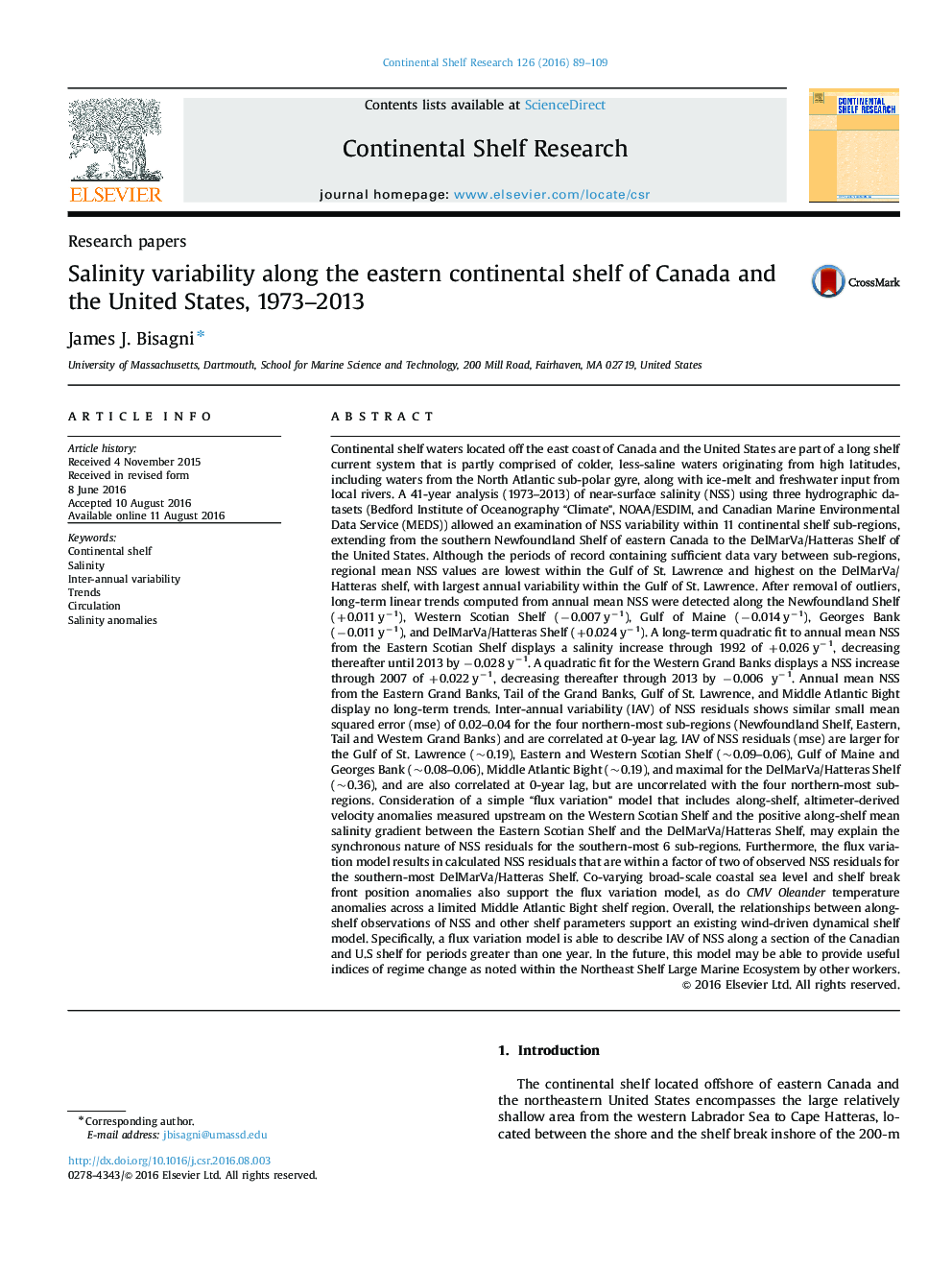| کد مقاله | کد نشریه | سال انتشار | مقاله انگلیسی | نسخه تمام متن |
|---|---|---|---|---|
| 4531524 | 1626087 | 2016 | 21 صفحه PDF | دانلود رایگان |

• Surface salinity shows long-term variability along the eastern seaboard of Canada and the U.S.
• Surface salinity variations are largely coherent over large regions of the continental shelf.
• Surface salinity variations are best explained by a flux variation across the along-shelf surface salinity gradient.
Continental shelf waters located off the east coast of Canada and the United States are part of a long shelf current system that is partly comprised of colder, less-saline waters originating from high latitudes, including waters from the North Atlantic sub-polar gyre, along with ice-melt and freshwater input from local rivers. A 41-year analysis (1973–2013) of near-surface salinity (NSS) using three hydrographic datasets (Bedford Institute of Oceanography “Climate”, NOAA/ESDIM, and Canadian Marine Environmental Data Service (MEDS)) allowed an examination of NSS variability within 11 continental shelf sub-regions, extending from the southern Newfoundland Shelf of eastern Canada to the DelMarVa/Hatteras Shelf of the United States. Although the periods of record containing sufficient data vary between sub-regions, regional mean NSS values are lowest within the Gulf of St. Lawrence and highest on the DelMarVa/Hatteras shelf, with largest annual variability within the Gulf of St. Lawrence. After removal of outliers, long-term linear trends computed from annual mean NSS were detected along the Newfoundland Shelf (+0.011 y−1), Western Scotian Shelf (−0.007 y−1), Gulf of Maine (−0.014 y−1), Georges Bank (−0.011 y−1), and DelMarVa/Hatteras Shelf (+0.024 y−1). A long-term quadratic fit to annual mean NSS from the Eastern Scotian Shelf displays a salinity increase through 1992 of +0.026 y−1, decreasing thereafter until 2013 by −0.028 y−1. A quadratic fit for the Western Grand Banks displays a NSS increase through 2007 of +0.022 y−1, decreasing thereafter through 2013 by −0.006 y−1. Annual mean NSS from the Eastern Grand Banks, Tail of the Grand Banks, Gulf of St. Lawrence, and Middle Atlantic Bight display no long-term trends. Inter-annual variability (IAV) of NSS residuals shows similar small mean squared error (mse) of 0.02–0.04 for the four northern-most sub-regions (Newfoundland Shelf, Eastern, Tail and Western Grand Banks) and are correlated at 0-year lag. IAV of NSS residuals (mse) are larger for the Gulf of St. Lawrence (~0.19), Eastern and Western Scotian Shelf (~0.09–0.06), Gulf of Maine and Georges Bank (~0.08–0.06), Middle Atlantic Bight (~0.19), and maximal for the DelMarVa/Hatteras Shelf (~0.36), and are also correlated at 0-year lag, but are uncorrelated with the four northern-most sub-regions. Consideration of a simple “flux variation” model that includes along-shelf, altimeter-derived velocity anomalies measured upstream on the Western Scotian Shelf and the positive along-shelf mean salinity gradient between the Eastern Scotian Shelf and the DelMarVa/Hatteras Shelf, may explain the synchronous nature of NSS residuals for the southern-most 6 sub-regions. Furthermore, the flux variation model results in calculated NSS residuals that are within a factor of two of observed NSS residuals for the southern-most DelMarVa/Hatteras Shelf. Co-varying broad-scale coastal sea level and shelf break front position anomalies also support the flux variation model, as do CMV Oleander temperature anomalies across a limited Middle Atlantic Bight shelf region. Overall, the relationships between along-shelf observations of NSS and other shelf parameters support an existing wind-driven dynamical shelf model. Specifically, a flux variation model is able to describe IAV of NSS along a section of the Canadian and U.S shelf for periods greater than one year. In the future, this model may be able to provide useful indices of regime change as noted within the Northeast Shelf Large Marine Ecosystem by other workers.
Journal: Continental Shelf Research - Volume 126, 1 September 2016, Pages 89–109